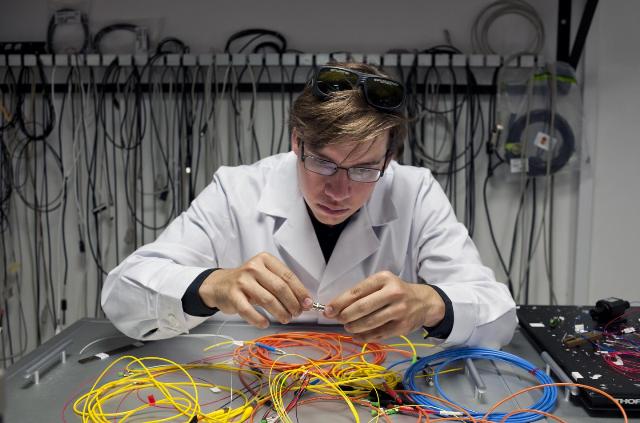Aug 21 2015
A team at the University of Warsaw, Faculty of Physics has created a laser capable of generating ultrashort pulses of light even under extremely difficult external conditions. This unique combination of precision and resilience is due to the fact that the whole process of generating femtosecond laser pulses takes place within a specially-selected optical fiber.
 Scientists at the Institute of Experimental Physics, Faculty of Physics, University of Warsaw have created a fiber-optic-based femtosecond laser. Above: Ph.D. student Jan Szczepanek at the lab. (Source: UW Physics, Grzegorz Krzy¿ewski)
Scientists at the Institute of Experimental Physics, Faculty of Physics, University of Warsaw have created a fiber-optic-based femtosecond laser. Above: Ph.D. student Jan Szczepanek at the lab. (Source: UW Physics, Grzegorz Krzy¿ewski)
Its appearance seems quite inconspicuous: just a flat, rectangular box, tens of centimeters across and about the same height, with a thin, shiny-tipped “thread” leading out of it, so long that it is rolled up into a coil. This small instrument, built by physicists from the Faculty of Physics at the University of Warsaw, Poland, is the first pulse laser of its type, capable of generating femtosecond light pulses under truly extreme environmental conditions. Its considerable resistance to external factors was achieved by forcing the entire laser-generating activity to occur directly within the optical fiber itself. As a result, the device has the simplest possible design, and is therefore highly dependable.
Femtosecond pulses last just a few millionths of a billionth of a second. The lasers used to generate such pulses usually require an optic resonator – a precision set of mirrors that is sensitive to external conditions. The instrument constructed at the UW Faculty of Physics, however, does not use mirros but an optical fiber.
“In our laser, the ultrashort pulses are generated directly in the fiber optic cable. The design is so simple that there is nothing that might break down”, says Dr. Yuriy Stepanenko (UW Faculty of Physics and IPC PAS). And he admits that his team treated the new laser in ways highly unrecommended by the manufacturers of normal precision optical instruments: “We turned on the laser and then heated up a segment of the optical fiber to more than 120 degrees Celsius. The temperature gradient was therefore really large, and the laser still worked well. We also put it into a shaker, with acceleration in excess of 7 g. It still worked afterwards, and most interestingly it also worked during the testing.”
The femtosecond laser from the UW Faculty of Physics generates pulses in an ytterbium-doped optical fiber. The wavelength of the light emitted is close to a micron (1030 nanometers), which can then be multiplied by generating higher-order harmonics.
“Optical fibers have for years been known as a source of laser radiation, including laser pulses. We have taken things a step further: we have carefully selected the right combination of laser pump diode and fiber optic cable, and developed a way to stabilize the whole system so that it is most energy-efficient for it to work in the pulse regime we wanted”, explains PhD student Jan Szczepanek (UW Faculty of Physics).
The optical fiber itself is flexible, and so laser pulses can be easily led into places inaccessible to traditional laser techniques. For industrial applications, it is no less important that the laser beam still preserves excellent spatial quality irrespective of how the fiber optic cable is positioned: its cross-section still shows the optimal “bell curve” (Gaussian distribution). The fiber optic cable, which acts as the main optical resonator, works with extraordinary stability, opening up the possibility of extending the laser to include further optical instruments in accordance with the users’ specific needs.
The “spaghetti noodle” laser, as its designers jokingly describe it, also has one more advantage: the simplicity of its design will make it a relatively inexpensive instrument. Built using commercially available components (a pump semiconductor diode and its driver), it would cost just a few thousand euro. Companies interested in commercializing the device could also seek additional ways to cut the cost, for instance by using a custom-designed driver.
Given its capacity to work stably under extremely difficult conditions, the femtosecond fiber-optic laser from the Institute of Experimental Physics, UW Faculty of Physics, is excellently suited for industrial applications, perhaps most promisingly in the field of micro-scale surface finishing. For instance, the ultrashort, femtosecond-duration pulses can be used to create micro-holes with smooth, precision-profiled edges. Other potential applications lie in cutting semiconducting solar panels and putting markings on such hard and precious materials as diamonds. Femtosecond lasers here have an advantage over instruments that generate longer pulses: the thermal stresses occurring in the material to be so marked are quite small, thus minimizing the risk of its discoloration or cracking. The “spaghetti noodle” laser could also be an important element of devices generating terahertz radiation, such as airport scanners, as well as refined measurement devices (such as in two-photon microscopy) and medical equipment (such as in optical coherence tomography, used to study soft tissues like the retina).